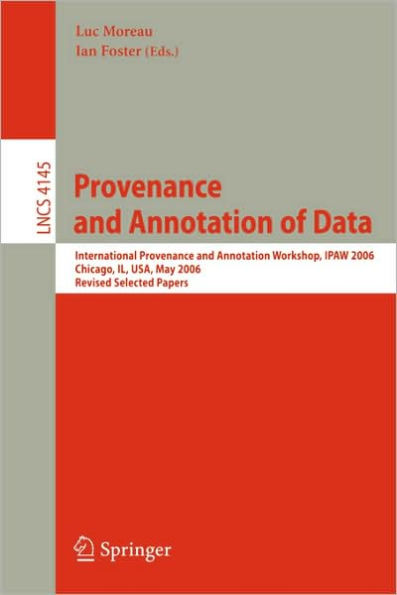Provenance and Annotation of Data: International Provenance and Annotation Workshop, IPAW 2006, Chicago, Il, USA, May 3-5, 2006, Revised Selected Papers
Provenance is a well understood concept in the study of—ne art, where it refers to the documented history of an art object. Given that documented history, the objectattains anauthority that allows scholarsto understandand appreciateits importance and context relative to other works. In the absence of such history, art objects may be treated with some skepticism by those who study and view them. Over the last few years, a number of teams have been applying this concept of provenance to data and information generated within computer systems. If the provenance of data produced by computer systems can be determined as it can for some works of art, then users will be able to understand (for example) how documents were assembled, how simulation results were determined, and how—nancial analyses were carried out. A key driver for this research has been e-Science. Reproducibility of results and documentation of method have always been important concerns in science, and today scientists of many fields (such as bioinformatics, medical research, chemistry, and physics) see provenanceas a mechanism that can help repeat scientificexperiments,verifyresults,andreproducedataproducts.Likewise,pro- nance offers opportunities for the business world, since it allows for the analysis of processes that led to results, for instance to check they are well-behaved or satisfy constraints; hence, provenance offers the means to check compliance of processes,on the basis of their actual execution. Indeed, increasing regulation of many industries (for example, financial services) means that provenance reco- ing is becoming a legal requirement.
1111359659
Provenance and Annotation of Data: International Provenance and Annotation Workshop, IPAW 2006, Chicago, Il, USA, May 3-5, 2006, Revised Selected Papers
Provenance is a well understood concept in the study of—ne art, where it refers to the documented history of an art object. Given that documented history, the objectattains anauthority that allows scholarsto understandand appreciateits importance and context relative to other works. In the absence of such history, art objects may be treated with some skepticism by those who study and view them. Over the last few years, a number of teams have been applying this concept of provenance to data and information generated within computer systems. If the provenance of data produced by computer systems can be determined as it can for some works of art, then users will be able to understand (for example) how documents were assembled, how simulation results were determined, and how—nancial analyses were carried out. A key driver for this research has been e-Science. Reproducibility of results and documentation of method have always been important concerns in science, and today scientists of many fields (such as bioinformatics, medical research, chemistry, and physics) see provenanceas a mechanism that can help repeat scientificexperiments,verifyresults,andreproducedataproducts.Likewise,pro- nance offers opportunities for the business world, since it allows for the analysis of processes that led to results, for instance to check they are well-behaved or satisfy constraints; hence, provenance offers the means to check compliance of processes,on the basis of their actual execution. Indeed, increasing regulation of many industries (for example, financial services) means that provenance reco- ing is becoming a legal requirement.
54.99
In Stock
5
1

Provenance and Annotation of Data: International Provenance and Annotation Workshop, IPAW 2006, Chicago, Il, USA, May 3-5, 2006, Revised Selected Papers
292
Provenance and Annotation of Data: International Provenance and Annotation Workshop, IPAW 2006, Chicago, Il, USA, May 3-5, 2006, Revised Selected Papers
292Paperback(2006)
$54.99
54.99
In Stock

Product Details
| ISBN-13: | 9783540463023 |
|---|---|
| Publisher: | Springer Berlin Heidelberg |
| Publication date: | 11/13/2006 |
| Series: | Lecture Notes in Computer Science , #4145 |
| Edition description: | 2006 |
| Pages: | 292 |
| Product dimensions: | 6.10(w) x 9.25(h) x 0.36(d) |
About the Author
From the B&N Reads Blog
